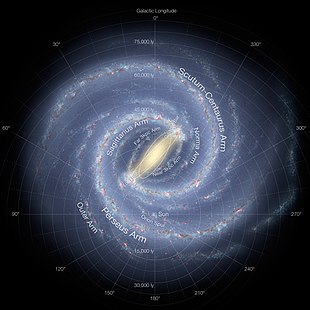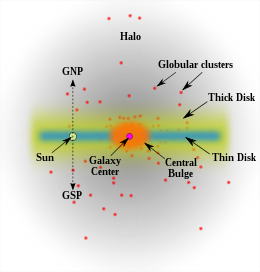藝術家對銀河系螺旋結構的構想顯示了巴德的一般星族類別。旋臂中的「藍色」區域由較年輕的I族恆星組成,而中心凸起中的「黃色」恆星是較年長的II族恆星。事實上,許多第一類恆星也被發現與較老的第二類恆星混合在一起。 星族 是沃爾特·巴德 在1944年 對銀河系 內的恆星群創建的分類。在巴德文章的摘要中,他認識到揚·歐特 在1926年 就已經設想過這種類型的分類[ 1]
巴德觀察到,較藍的恆星與旋臂强烈相關,黃色恆星在中心星系核球 附近和在球狀星團 內占主導地位[ 2] 星族I 星族II 星族III
在星族類型中,發現它們各自觀測到的恆星光譜存在顯著差異。這些後來被證明是非常重要的,可能與恆星的形成有關,觀察到運動學 [ 3] 螺旋 和橢圓 星系中的星系演化 。這三個簡單的星族類別根據它們的化學成分或金屬量 對恆星進行了有效的劃分[ 4] [ 5] [ 3]
根據定義,每個星族都顯示出金屬含量下降,表明恆星年齡增加的趨勢。因此,宇宙中最早的恆星(金屬含量很低)被認為是星族III,老恆星(金屬豐度低)被視為星族II,最近的恆星(高金屬豐度)被視是星族I[ 6] 太陽 被認為是星族I,是一顆較新的恆星,金屬豐度相對較高,為1.4%。請注意,天體物理學命名法認為任何比氦 重的元素都是金屬 ,包括化學的非金屬 ,如氧[ 7]
對恆星光譜 的觀測表明,與太陽相比,比太陽年齡大的恆星含有更少的重元素[ 3] 恆星核合成 的過程通過恆星的世代演化而來的。
根據現時的宇宙學模型,大爆炸 中產生的所有物質大多是氫 (75%)和氦 (25%),只有極少數的其它輕元素組成,如鋰 和鈹 [ 8] 核合成 過程創造了前26種元素(在週期表 中高達鐵 )[ 9]
許多恆星模型理論表明,大多數高質量III族恆星都會迅速耗盡燃料,很可能在能量極高的不穩定狀態 中爆炸。這些爆炸會徹底分散它們的物質,將金屬噴射到星際介質(ISM)中,並融入到下一代恆星中。它們的毀滅表明,在銀河系中應該觀測不到高質量的III族恆星[ 10] 紅移 星系中[ 11] 銀河系 旋臂的聯星系統中發現了一顆金屬量相較於太陽極其小的超貧金屬恆星 的證據。這一發現開啟了觀測更古老恆星的可能性[ 12]
恆星質量太大,無法產生成對不穩定的超新星,很可能會通過一個被稱為光致蛻變 的過程坍塌成黑洞 。在這個過程中,一些物質可能以相對論性噴流 的形式逃逸,這可能將第一批金屬散佈到宇宙中[ 13] [ 14] [ a]
迄今為止觀測到的最古老的恆星[ 10] [ 16] [ 6] 氣體 星雲接受了前幾代恆星從星族III製造的富含金屬的宇宙塵埃 。
當這些星族II的恆星死亡時,它們通過行星狀星雲 和超新星將富含金屬的物質返回星際介質 ,進一步富集星雲,而新恆星又由這些星雲形成。這些最年輕的恆星,包括太陽 ,因此具有最高的金屬含量,被稱為星族I恆星。
第一星族星參宿七 和反射星雲 IC 2118 。 第一星族星 (亦稱星族Ⅰ星)包含相當數量比氦 重的元素(天文學中統稱為「金屬」)。這些重元素的來源是上一代恆星經由超新星 爆炸,或來自行星狀星雲 物質擴散的過程散佈出來的。
星族I,或稱富金屬恆星,是三個星族中金屬豐度最高的年輕恆星,更常見於像銀河系 這種星系的旋臂 。太陽 是富含金屬恆星的一個例子,被認為是一顆星族I中間的恆星,而類似太陽的天壇座μ 則富含金屬[ 17]
星族I的恆星通常具有繞著銀河中心 的規則橢圓軌道 ,並且有著較低的相對速度 。早期有人假設,星族I的高金屬内容使它們比其他兩類恆星更有可能擁有行星系 ,因為行星 ,特別是類地行星 ,被認為是由金屬的吸積 形成的[ 18] 克卜勒太空望遠鏡 觀測的數據發現,在具有一定金屬量的恆星周圍有較小的行星,而只有較大的、潜在的氣態巨行星集中在金屬量相對較高的恆星周圍:這一發現對氣態巨行星形成的理論有所啟發[ 19]
銀河系剖面示意圖。 第二星族星出現在銀河系的核球和球狀星團內。 第二星族星(星族II),或稱貧金屬星,是指那些比氦重的元素相對較少的恆星。這些天體形成於宇宙早期。在銀河系 中心附近的核球 中,中間的星族II恆星很常見,而在星系暈 中發現的星族II恆星更古老,因此更缺乏金屬[ 20]
第二星族星的一個特徵是,儘管它們的總體金屬量較低,但與第一類恒星相比,它們的“α過程元素 ”(由氦核作用 產生的元素,如氧 和氖 )相對於鐵 (Fe)的比例往往更高;現時的理論認為,這是II型超新星 在形成時對星際介質 有更重要貢獻的結果,而Ia型超新星 金屬富集發生在宇宙發展的後期[ 21]
科學家們在幾次不同的調查中瞄準了這些最古老的恒星,包括Timothy C.Beers [ 22] ESO 對諾伯特·克裏斯特利布等等的巡天[ 23] 類星體 。到目前為止,他們已經發現並詳細研究了大約十顆超貧金屬星(UMP)(如斯涅登星 凱雷爾星 、 BD +17° 3248 )和迄今為止已知的三顆最古老的恒星:HE 0107-5240 、HE 1327-2326 和HE 1523-0901 。卡福星 是在2012年使用史隆數位巡天 數據發現的,它被確定為迄今為止金屬含量最低的超貧金屬星。然而,2014年2月,在SkyMapper 天文量測數據的幫助下,宣佈發現了一顆金屬豐度更低的恒星,SMSS J031300.36-670839.3 。HD 122563 (一顆紅巨星 )和HD 140283 (一顆次巨星 )在金屬貧乏方面不那麼極端,但更接近、更明亮,因此更為人所知。
第二星族星的年齡比第一星族星大了許多,但是卻被分配了關係相反的數字來區分,這是歷史上遺留下來的原因,因為在第一次對恆星做巡天的探測時,那時並不明瞭某一類恆星的金屬含量會比另一類恆星多的原因。
美國國家航空暨太空總署 的史匹哲太空望遠鏡 拍攝到可能是星族III恆星發出的輝光。 藝術家概念下的印象顯示了一個第三星族星(星族III)恆星的區域。因為它們在宇宙大爆炸 後僅僅1億年就出現了 第三星族星(星族III)[ 24] 「金屬」 的恆星。
星族III這個詞最早是由Neville J.Woolf在1965年提出的[ 25] [ 26] 氫 更重的化學元素 ,這是我們所知的行星 和生命 後期形成所需的[ 27] [ 28]
第三星族星的存在是從物理宇宙學 推斷出來的,但它們還沒有被直接觀測到。在宇宙中一個非常遙遠的引力透鏡星系 中發現了它們存在的間接證據[ 29] 類星體 的發射光譜 中觀察到了重元素,而這些元素原本不可能在大爆炸 中產生[ 9] 暗藍星系 的組成部分。這些恆星很可能引發了宇宙的再電離 時期,這是構成大部分星際介質的氫氣的主要相變 。對星系UDFy-38135539 的觀測表明,它可能在這一再電離過程中發揮了作用。歐洲南方天文台 在宇宙大爆炸後約8億年的再電離時期,在非常明亮的星系宇宙紅移7 中,在「z」=6.60 [ 27] [ 30] [ 31]
藝術家對宇宙大爆炸 後的4億年,第一批恆星的印象。 現時的理論對第一批恆星的質量是否很大存在分歧。一種可能性是,這些恆星比現時的恆星大得多:幾百顆太陽質量 ,可能高達1,000個太陽質量。這樣的恆星壽命很短,只有200-500萬年[ 32] 星際介質 溫度仍然高得多[來源請求] [ 33] [ 34] [ 35] M ☉ )或更小的恆星,在積累更多質量之前從其出生星團中噴出,它可以存活到現在,甚至可能在我們的銀河系中[ 36]
對HE 0107-5240 等極低金屬量 第二星族星的資料分析表明,這些無金屬恒星的質量為20~130太陽質量,這些恒星被認為含有第三星族星產生的金屬[ 37] 橢圓星系 相關的球狀星團 的分析表明,不穩定對超新星 ,通常與大質量恒星相關,是其金屬量 組成的原因[ 38] 金屬量 的低質量恒星[ 39] [ 40] 紅矮星 或棕矮星 星團(可能由不穩定對超新星產生[ 16] 暗物質 候選者[ 41] [ 42] 引力微透鏡 對這些類型的MACHO 的蒐索產生了負面結果[來源請求]
第二星族星被認為是早期宇宙中黑洞的種子,但與直接坍塌黑洞 黑洞 種子不同,它們會產生低質量的恒星,如果它們能生長到比預期質量更大的質量,那麼它們可能是類星 ,在氫和氦被較重元素污染之前,大質量黑洞的其它假設種子可能存在於宇宙早期發展階段。
探測第三星族星(星族III)是美國國家航空暨太空總署詹姆斯·韋伯太空望遠鏡 的一個目標[ 43] 光譜 調查,如SEGUE 或SDSS-II ,也可能定位在找出星族III恒星[來源請求]
2022年12月8日,天文學家報告可能探測到第三星族星[ 44] [ 45]
^
Baade, W. The resolution of Messier 32, NGC 205, and the central region of the Andromeda nebula . Astrophysical Journal. 1944, 100 : 137–146. Bibcode:1944ApJ...100..137B doi:10.1086/144650 The two types of stellar populations had been recognized among the stars of our own galaxy by Oort as early as 1926.
^
Shapley, Harlow . Hodge, Paul , 编. Galaxies 62–63 . ISBN 978-0674340510
^ 3.0 3.1 3.2 Gibson, B.K.; Fenner, Y.; Renda, A.; Kawata, D.; Hyun-chul, L. Review: Galactic chemical evolution (PDF) . Publications of the Astronomical Society of Australia (CSIRO publishing). 2013, 20 (4): 401–415 [17 April 2018] . Bibcode:2003PASA...20..401G S2CID 12253299 arXiv:astro-ph/0312255 doi:10.1071/AS03052 原始内容 (PDF) 存档于2021-01-20). ^ Kunth, Daniel & Östlin, Göran. The most metal-poor galaxies . The Astronomy and Astrophysics Review . 2000, 10 (1): 1–79 [3 January 2022] . Bibcode:2000A&ARv..10....1K S2CID 15487742 arXiv:astro-ph/9911094 doi:10.1007/s001590000005 存档 于2018-09-16) –通过caltech.edu. ^ Schönrich, R.; Binney, J. Origin and structure of the Galactic disc(s). Monthly Notices of the Royal Astronomical Society. 2009, 399 (3): 1145–1156. Bibcode:2009MNRAS.399.1145S arXiv:0907.1899 doi:10.1111/j.1365-2966.2009.15365.x ^ 6.0 6.1 Bryant, Lauren J. What makes stars tick . Research & Creative Activity. Indiana University . [September 7, 2005] . (原始内容 存档于2016-05-16). ^ Metals . astronomy.swin.edu.au. Cosmos. [2022-04-01 ] . ^
Cyburt, Richard H.; Fields, Brian D.; Olive, Keith A.; Yeh, Tsung-Han. Big bang nucleosynthesis: Present status. Reviews of Modern Physics . 2016, 88 (1): 015004. Bibcode:2016RvMP...88a5004C S2CID 118409603 arXiv:1505.01076 doi:10.1103/RevModPhys.88.015004
^ 9.0 9.1
Heger, A.; Woosley, S.E. The nucleosynthetic signature of Population III. Astrophysical Journal . 2002, 567 (1): 532–543. Bibcode:2002ApJ...567..532H S2CID 16050642 arXiv:astro-ph/0107037 doi:10.1086/338487
^ 10.0 10.1
Schlaufman, Kevin C.; Thompson, Ian B.; Casey, Andrew R. An ultra metal-poor star near the hydrogen-burning Limit. The Astrophysical Journal. 2018, 867 (2): 98. Bibcode:2018ApJ...867...98S S2CID 54511945 arXiv:1811.00549 doi:10.3847/1538-4357/aadd97
^ Xu, Hao; Wise, John H.; Norman, Michael L. Population III stars and remnants in high-redshift galaxies. The American Astronomical Society. 29 July 2013, 773 (2): 83. Bibcode:2013ApJ...773...83X S2CID 118303030 arXiv:1305.1325 doi:10.1088/0004-637X/773/2/83 ^ One of Milky Way's oldest stars discovered . Sci-News. 6 November 2018 [12 June 2020] . (原始内容存档 于2018-11-06). ^
Fryer, C. L.; Woosley, S. E.; Heger, A. Pair-instability supernovae, gravity waves, and gamma-ray transients. The Astrophysical Journal. 2001, 550 (1): 372–382. Bibcode:2001ApJ...550..372F S2CID 7368009 arXiv:astro-ph/0007176 doi:10.1086/319719
^
Heger, A.; Fryer, C. L.; Woosley, S. E.; Langer, N.; Hartmann, D. H. How massive single stars end their life. The Astrophysical Journal. 2003, 591 (1): 288–300. Bibcode:2003ApJ...591..288H S2CID 59065632 arXiv:astro-ph/0212469 doi:10.1086/375341
^ Clark, Stuart. Primordial giant: The star that time forgot . New Scientist . February 2010 [1 February 2015] . (原始内容存档 于2015-04-23). ^ 16.0 16.1
Salvaterra, R.; Ferrara, A.; Schneider, R. Induced formation of primordial low-mass stars. New Astronomy. 2004, 10 (2): 113–120. Bibcode:2004NewA...10..113S S2CID 15085880 arXiv:astro-ph/0304074 doi:10.1016/j.newast.2004.06.003
^
Soriano, M.S.; Vauclair, S. New seismic analysis of the exoplanet-host star Mu Arae. Astronomy and Astrophysics. 2009, 513 : A49. Bibcode:2010A&A...513A..49S S2CID 5688996 arXiv:0903.5475 doi:10.1051/0004-6361/200911862
^
Lineweaver, Charles H. An estimate of the age distribution of terrestrial planets in the universe: Quantifying metallicity as a selection effect. Icarus. 2000, 151 (2): 307–313. Bibcode:2001Icar..151..307L S2CID 14077895 arXiv:astro-ph/0012399 doi:10.1006/icar.2001.6607
^
Buchhave, L.A.; et al. An abundance of small exoplanets around stars with a wide range of metallicities. Nature . 2012, 486 (7403): 375–377. Bibcode:2012Natur.486..375B PMID 22722196 S2CID 4427321 doi:10.1038/nature11121
^
van Albada, T. S.; Baker, N. On the two Oosterhoff groups of globular clusters. Astrophysical Journal . 1973, 185 : 477–498. Bibcode:1973ApJ...185..477V doi:10.1086/152434
^ Wolfe, Arthur M.; Gawiser, Eric; Prochaska, Jason X. Damped Ly‑α systems . Annual Review of Astronomy and Astrophysics. 2005, 43 (1): 861–918 [2024-01-27 ] . Bibcode:2005ARA&A..43..861W S2CID 119368187 arXiv:astro-ph/0509481 doi:10.1146/annurev.astro.42.053102.133950 存档 于2018-11-21). ^ Beers, T. C.; Preston, G. W.; Shectman, S. A. A Search for Stars of Very Low Metal Abundance. II. Astronomical Journal . 1992, 103 : 1987. Bibcode:1992AJ....103.1987B S2CID 121564385 doi:10.1086/116207 ^ Christlieb, N.; Wisotzki, L.; Reimers, D.; Gehren, T.; Reetz, J.; Beers, T. C. An Automated Search for Metal-Poor Halo Stars in the Hamburg/ESO Objective-Prism Survey. ASP Conference Series. 1998, 666 . arXiv:astro-ph/9810183v1 ^
Tominga, N.; et al. Supernova nucleosynthesis in population III 13-50 Msolar stars and abundance patterns of extremely metal-poor stars. Astrophysical Journal . 2007, 660 (5): 516–540. Bibcode:2007ApJ...660..516T S2CID 119496577 arXiv:astro-ph/0701381 doi:10.1086/513063
^ Green, Louis. Observational Aspects of Cosmology . Sky and Telescope. April 1966, 31 : 199. Bibcode:1966S&T....31..199G ^ Thornton, Page. Observational Aspects of Cosmology . Science. March 1966, 151 (3716): 1411–1414,1416–1418 [2024-01-27 ] . Bibcode:1966Sci...151.1411P 存档 于2023-05-10). ^ 27.0 27.1
Sobral, David; Matthee, Jorryt; Darvish, Behnam; Schaerer, Daniel; Mobasher, Bahram; Röttgering, Huub J.A.; Santos, Sérgio; Hemmati, Shoubaneh. Evidence for Pop III-like stellar populations in the most luminous Lyman-α emitters at the epoch of re-ionisation: Spectroscopic confirmation. The Astrophysical Journal . 4 June 2015, 808 (2): 139. Bibcode:2015ApJ...808..139S S2CID 18471887 arXiv:1504.01734 doi:10.1088/0004-637x/808/2/139
^ Overbye, Dennis . Astronomers report finding earliest stars that enriched the cosmos . The New York Times . 17 June 2015 [17 June 2015] . (原始内容存档 于2019-06-29). ^
Fosbury, R.A.E.; et al. Massive star formation in a gravitationally lensed H II galaxy at z = 3.357. Astrophysical Journal . 2003, 596 (1): 797–809. Bibcode:2003ApJ...596..797F S2CID 17808828 arXiv:astro-ph/0307162 doi:10.1086/378228
^
Best observational evidence of first-generation stars in the universe . Astronomy Magazine . 17 June 2015.
^
Bromm, V.; Yoshida, N.; Hernquist, L.; McKee, C.F. The formation of the first stars and galaxies. Nature . 2009, 459 (7243): 49–54. Bibcode:2009Natur.459...49B PMID 19424148 S2CID 10258026 arXiv:0905.0929 doi:10.1038/nature07990
^
Ohkubo, Takuya; Nomoto, Ken'ichi; Umeda, Hideyuki; Yoshida, Naoki; Tsuruta, Sachiko. Evolution of very massive Population III stars with mass accretion from pre-main sequence to collapse. The Astrophysical Journal . 2009-12-01, 706 (2): 1184–1193. Bibcode:2009ApJ...706.1184O ISSN 0004-637X arXiv:0902.4573 doi:10.1088/0004-637X/706/2/1184
^ Redd, Nola. The universe's first stars weren't loners after all . Space.com. February 2011 [1 February 2015] . (原始内容存档 于2018-11-21). ^ Thompson, Andrea. How massive stars form: Simple solution found . Space.com. January 2009 [1 February 2015] . (原始内容存档 于2019-02-03). ^ Carr, Bernard J. Cosmology, Population III . California Institute of Technology . [2024-01-27 ] . (原始内容存档 于2017-10-20). ^
Dutta, J.; Sur, S.; Stacy, A.; Bagla, J.S. Modeling the Survival of Population III Stars to the Present Day. The Astrophysical Journal. 2020, 901 (1): 16. Bibcode:2020ApJ...901...16D S2CID 209386374 arXiv:1712.06912 doi:10.3847/1538-4357/abadf8
^
Umeda, Hideyuki; Nomoto, Ken'Ichi. First-generation black-hole-forming supernovae and the metal abundance pattern of a very iron-poor star. Nature . 2003, 422 (6934): 871–873. Bibcode:2003Natur.422..871U PMID 12712199 S2CID 4424736 arXiv:astro-ph/0301315 doi:10.1038/nature01571
^
Puzia, Thomas H.; Kissler‐Patig, Markus; Goudfrooij, Paul. Extremely α‐enriched globular clusters in early‐type galaxies: A step toward the dawn of stellar populations?. The Astrophysical Journal . 2006, 648 (1): 383–388. Bibcode:2006ApJ...648..383P S2CID 9815509 arXiv:astro-ph/0605210 doi:10.1086/505679
^
Siess, Lionel; Livio, Mario; Lattanzio, John. Structure, evolution, and nucleosynthesis of primordial stars. The Astrophysical Journal . 2002, 570 (1): 329–343. Bibcode:2002ApJ...570..329S S2CID 18385975 arXiv:astro-ph/0201284 doi:10.1086/339733
^ Gibson, Carl H.; Nieuwenhuizen, Theo M.; Schild, Rudolph E. Why are so many primitive stars observed in the Galaxy halo. Journal of Cosmology. 2013, 22 : 10163. Bibcode:2013JCos...2210163G arXiv:1206.0187 ^
Kerins, E.J. Zero-metallicity very low mass stars as halo dark matter. Astronomy and Astrophysics . 1997, 322 : 709. Bibcode:1997A&A...322..709K arXiv:astro-ph/9610070
^
Sanchez-Salcedo, F.J. On the stringent constraint on massive dark clusters in the galactic halo. Astrophysical Journal Letters. 1997, 487 (1): L61. Bibcode:1997ApJ...487L..61S doi:10.1086/310873
^
Rydberg, C.-E.; Zackrisson, E.; Lundqvist, P.; Scott, P. Detection of isolated population III stars with the James Webb Space Telescope. Monthly Notices of the Royal Astronomical Society . March 2013, 429 (4): 3658–3664. Bibcode:2013MNRAS.429.3658R arXiv:1206.0007 doi:10.1093/mnras/sts653
^ Wang, Xin; et al. A strong He II λ1640 emitter with extremely blue UV spectral slope at z=8.16: presence of Pop III stars?. 8 December 2022. arXiv:2212.04476 astro-ph.GA ]. ^ Callaghan, Jonathan. Astronomers Say They Have Spotted the Universe's First Stars - Theory has it that "Population III" stars brought light to the cosmos. The James Webb Space Telescope may have just glimpsed them. . Quanta Magazine . 30 January 2023 [31 January 2023] . (原始内容存档 于2023-02-09).





